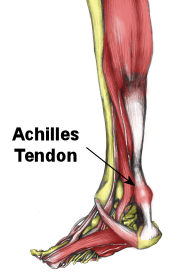Of body parts in the dance world, the Achilles tendon is perhaps one of the more infamous.
What’s in a name?
Achilles was a figure of Greek Mythology refuted as an infallible hero of the Trojan War – infallible, of course, except for the small injury to his heel that killed him. Consequently, the term “Achilles Heel” is used to describe the greatest weakness of an individual, and the small tendon connecting the calf muscle (triceps surae) to the heel bone (calcaneus) is called the Achilles tendon.
Tendons are the fibrous, elastic structures at the end of each skeletal muscle.
Their job is to connect muscles to bones, and to store elastic energy (that is then converted into mechanical forces acting on the bone, enabling movement to occur).
Tendonopathies
 Injury to any tendon is universally referred to as tendonopathy.
Injury to any tendon is universally referred to as tendonopathy.
The most commonly injured tendons in dancers are the Achilles tendon, peroneal tendons, posterior tibial tendons and Flexor hallucis longus (FHL).
Dancing places frequent stress on the Achilles tendon. Achilles tendonitis occurs when the tendon becomes inflamed due to overuse, excessive pronation, bowlegs, tight Achilles tendons, or abnormally shaped heel bones (Hodgkins, Kennedy & O’Loughlin, 2008).
The likelihood of developing Achilles tendonitis increases if you use improper technique (Motta-Valencia, 2006).
Forcing your turnout causes the foot to pronate placing further stress on the Achilles tendon (Kadel, 2006).
Failure to press the heels into the ground following jumps, or to rise completely to full 3/4 toe in relevé, shortens the tendon and puts the dancer at further risk for tendonitis and/or rupture of the tendon (Kadel, 2006).
How can I prevent tendonitis?
First and foremost, be diligent in your technique. Dancers with improper technique are more likely to develop injuries, including Achilles tendonitis. Be sure to press the heels down while jumping and use proper alignment of the foot in turnout and jump landings.
As I stated in my recent post on knee injuries, environmental factors can greatly contribute to your chance of sustaining an injury. Hard, unsprung floors, raked stages, and cold temperatures are all risk factors for Achilles tendonitis. Futhermore, shoes and/or ribbons that are too tight place unwanted stress on the tendon and can exacerbate tendonitis.
If I have Achilles tendonitis, does it go away?
Well, that’s kind of a trick question…
Tendonitis (tendinitis is also an accepted spelling) is an acute inflammation of the tendon, and it can go away with proper treatment (generally including rest, ice, strapping the tendon and anti-inflammatory drugs). Tendonitis can and will go away if you take the proper steps to treat it, and prevent it from recurring.
As I mentioned above, some dancers will be predisposed to tendonitis because of their anatomy (e.g. short tendons, bowlegs, malformed calcaneous, etc.). It is exceedingly important that these dancers take the proper steps to prevent flare-ups.
Repeated occurrences of tendonitis can lead to a chronic and more serious condition called tendonosis. Tendonosis can develop if acute bouts of tendonitis are not treated properly or the dancer does not take adequate time to rest. If tendonitis progresses to tendonosis, persistent inflammation leads to degeneration and the formation of nodules on the tendon and the dancer is at an increased risk of rupturing the tendon (You may recall dancer, Alex Wong’s injury in 2010, brought to the world’s attention via the televised So You Think You Can Dance).
Further tips for preventing Achilles tendonopathy:
- Mind your technique. (Coming through, loud and clear?) Be diligent in pressing your heels down when landing from jumps, returning from grand plié. Don’t force turnout or over-pronate.
- Make sure your shoes fit properly and aren’t pinching the back of your heel
- Sew elastic into pointe shoe ribbons at the point where they cross the back of the leg and tie shoes less tight, relieving pressure placed on the tendon (Kadel, 2006). Bloch and Bunheads are now manufacturing “tendonitis ribbons” with elastic already sewn in.
- Warm-up! Warm muscles and tendons are less likely to become inflammed and injured under repeated stress
- Increase your flexibility by performing a calf stretch (when properly warmed-up or after class), or using an angled stretch box, and prevent shortening of the tendon by always rising to your highest relèvé. More ways to stretch the achilles tendon are found here.
Many dancers have struggled with Achilles tendonitis at some point during their careers (including me).
Do you have a story you can share?
—
References:
Beers, M. H. (2003). The merck manual of medical information, second home edition. Pocket Books, 424-425.
Fernandez-Palazzi, F., Rivas, S. & Mujica, P. (1990). Achilles tendonitis in ballet dancers. Clin Orthop Relat Res 257, 257-261.
Hodgkins, C. W., Kennedy, J. G. & O’Loughlin, P. F. (2008). Tendon injuries in dance. Clin Sports Med 27, 278-288.
Kadel, N. J. (2006). Foot and ankle injuries in dance. Physical Medicine and Rehabilitation Clinics of America 17, 813-826.
Motta-Valencia, K. (2006). Dance-related injury. Physical Medicine and Rehabilitation Clinics of North America 17, 697-723.
Lauren Warnecke is a freelance writer and editor, focused on dance and cultural criticism in Chicago and across the Midwest. Lauren is the dance critic for the Chicago Tribune, editor of See Chicago Dance, and founder/editor of Art Intercepts, with bylines in Chicago Magazine, Milwaukee Magazine, St. Louis Magazine and Dance Media publications, among others. Holding degrees in dance and kinesiology, Lauren is an instructor of dance and exercise science at Loyola University Chicago. Read Lauren’s posts.


